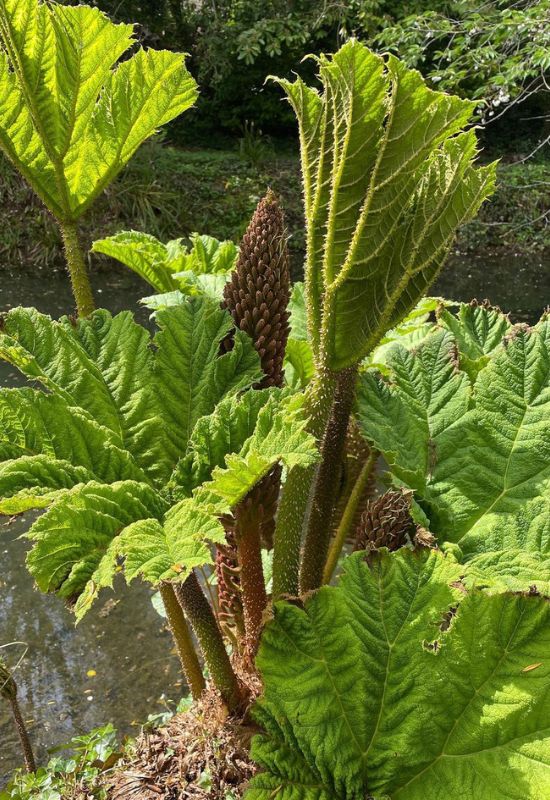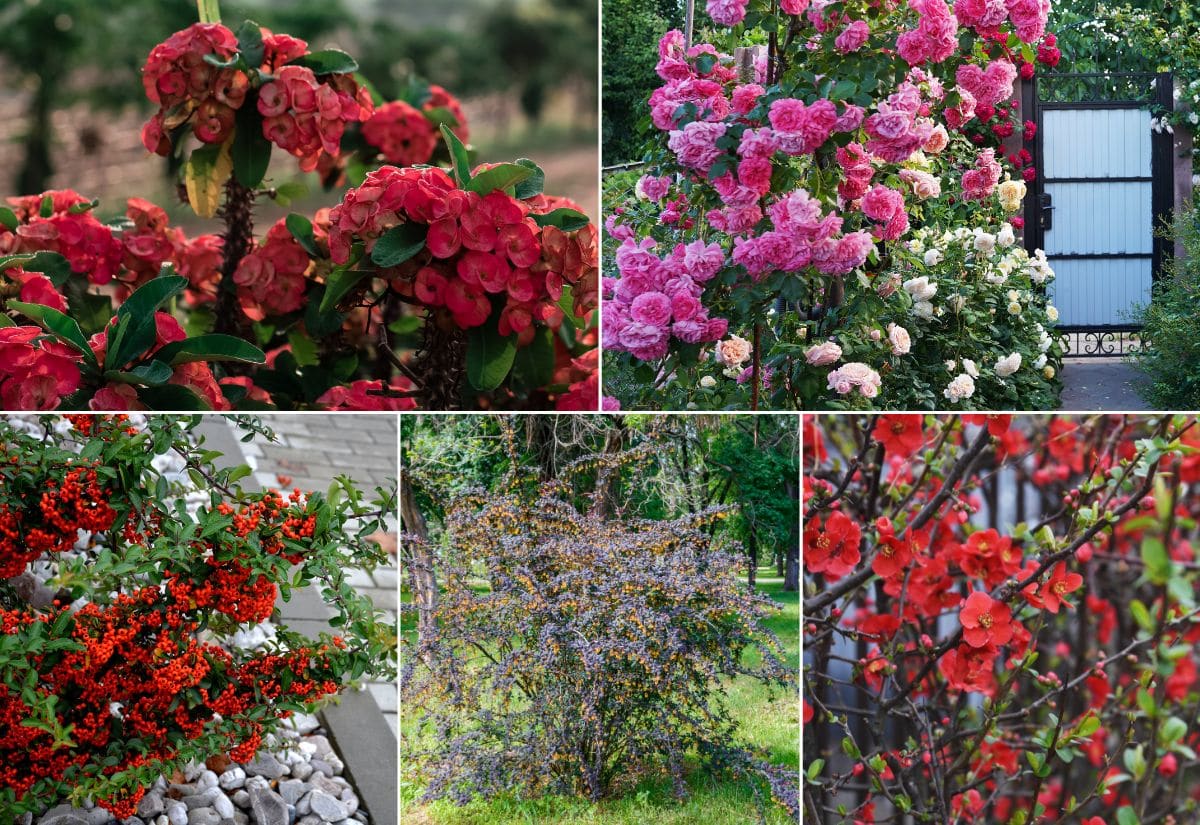
Plants give us oxygen, they fill our gardens and prairies with seas of colorful flowers, they feed pollinators, they give us lush foliage under trees – and they defend themselves from hungry mammals with sharp thorns! Not all of them, but spines, prickles and even bristles are quite common in the flora of the whole world.
They use them to protect their juicy leaves from herbivores, but if you pick them, you risk a nasty sting yourself, or your children… And some can be really painful indeed. But they can come to your aid as well. Thorny shrubs, for example, are excellent in hedges and around fences and gates to keep unwelcome intruders away: and that includes humans!
What’s more, flowering plants with thorns can be quite attractive, and in fact they are in many cases – just think about a cactus, for example!
So, if your garden needs some flowering shrubs, trees, vines, and succulents for decorative blooms, but also some thorns for protection, here’s a selection of prickly varieties you can grow – and have the best of both worlds!
First of all, however, let’s be precise: what’s the difference between a thorn, a spine and a prickle?
Flowering Plants with Thorns, Spines and Prickles – What’s the Difference?
Now, we call them thorns, spines and prickles, and for most of us they all to mean the same thing, but are they? To be precise, they are not, at least for botanists and gardeners… So, let’s see the difference…
So, ironically, roses have no thorns, but prickles! Anyway, we wanted to make the point, just to be precise, but in the article, we will use thorns to mean any of them, and maybe specify in each case.
And now, put your gloves on, and get ready for a thorny (spiny and prickly) but also very beautiful journey!
15 Thorny Plants with Lots of Flowers for Your Garden
Whether you want a plant variety just for its decorative blooms, or because you actually need thorns for privacy and even safety, here are 15 of the best flowering plants that can sting, if you are not careful…
1: Rose (Rosa spp.)
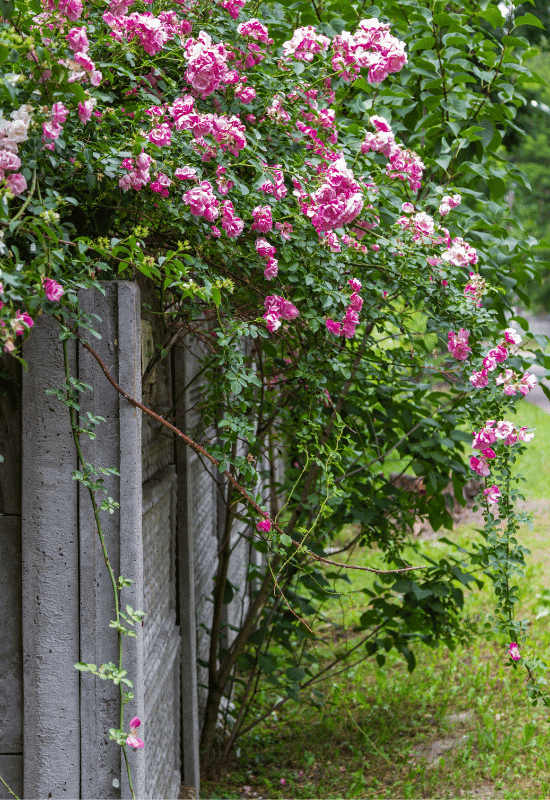
You expected this! Of course, the thorny queen of gardens deserves the first place on our list (which is not a “chart” anyway)…But, as we said, roses does not have thorns, but prickles, and the proof is that you can snap them off very easily, without breaking the tissue underneath.
Then again, breeders have selected rose varieties with fewer and fewer “spikes”, and now we have rose cultivars that are totally smooth! But if you want a shrub or climber to keep unwanted visitors away, you still have a huge choice, with double and single flowers, blooming at different times, with blossoms that range from 1 to 8 inches across (2.5 to 20 cm)!
Then again, you can choose from an amazing palette with white, yellows, oranges, pinks, reds and purples, and some rare beauties also have dashes of green (the viridiflora group)!
But we cannot ignore the range of fragrances, with fruity, musky, green tea and spicy notes!
The hips that follow are edible, and great for jellies… And the foliage is itself a decorative asset, sometimes deep green and glossy, and often with copper and purple tonalities, especially when young.
I don’t think I need to convince you that the first option that springs to mind when if you want a flowering plant with “thorns” is the world’s favorite flower, the rose… But you can also choose how thorny a variety you want to have, and you can have them in containers, on fences and harbors, in hedges and borders, and why not have a full-blown rose garden?
2: Crown of Thorns (Euphorbia milii)
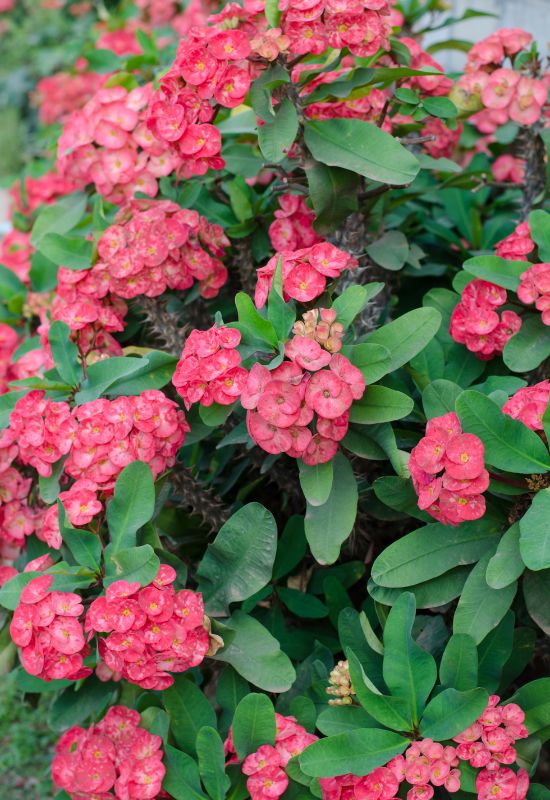
Also called Christ plant, crown of thorns is a quirky shrubby succulent native to Madagascar, where the flora is otherworldly, and belonging to the huge genus Euphorbia. Its common name comes from its appearance and thorny personality…
But in this case, we are talking about real thorns, which grow on the grayish branches, and they look very threatening indeed.
They can prick you, true, but the actual stems are soft, despite their look! The evergreen leaves are ovate, small and deep emerald green most of the time, but they can blush to orange, reddish and even purplish shades depending on the season and light conditions.
And here we come to an important asset of this plant: it blossoms literally all year round! The actual flowers are small, but they are framed by two bean shaped bracts that stand out like drops of blood, because they are usually scarlet red.
And they last for months and months on end! And there are now varieties in pink, rose, cream, white, pale lime to lemon yellow and even orange! And it is a winner of the Award of Garden Merit by the Royal Horticultural Society as well…
Typical of Mediterranean gardens and in containers or yards in hot places, crown of thorns is a very evocative spiny plant, which gives you a great spectacle all year round.
However, if you want to use it to keep unwanted visitors away, you will have to wait, because it is really slow growing! On the other hand, its spines are of great esthetic value on their own, adding a harsh and exotic twist to any space!
3: Common Hawthorn (Crataegus monogyna)
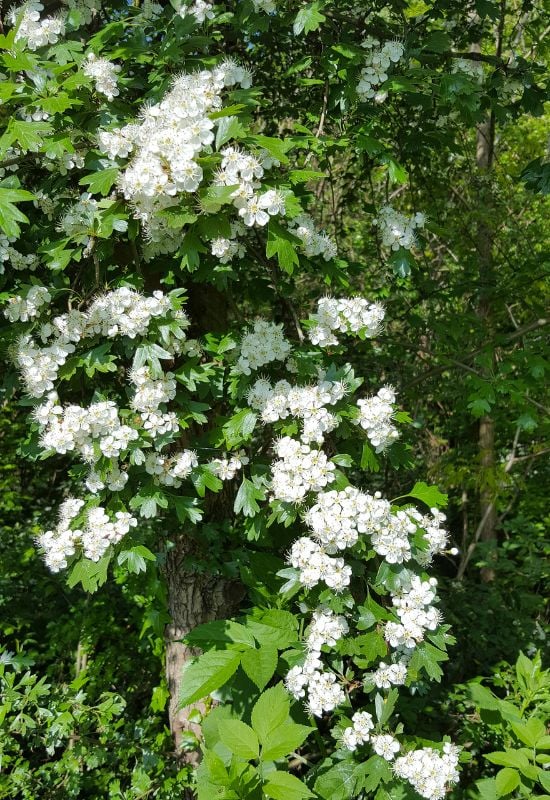
And we cone to a classic thorny shrubby tree of temperate and woodland areas, so widespread along the edges of mountain pastures: common hawthorn… Cold hardy and very vigorous, it is native to north Africa, western Asia and Europe, and it has not been misnamed…
Yes, because it has actual thorns, that grow straight from the bark of the woody branches, and they point towards the tips.
So, be careful if you want to pick its massive spring blooms! Wear gloves and grab them from below, because they are very sharp indeed! And they are long, about 1 inch (2.5 cm). On the other hand, its floral display is really impressive!
A huge number of single rose-like little flowers cover it completely, with flat clusters of snow white candor! It’s like a cloud has suddenly fallen down to earth from the sky! Look closely and you will also see very elegant stamens form rays of elegance, and a cream colored center.
But you will also be taken by the fragrance of these generous blossoms, which then turn into glossy ruby red berries (called “haws”) which are edible and very nutritious, and a magnet for little chirping birds!
The deciduous foliage is very lush indeed and extremely decorative. Bright green and semi glossy, it forms a mound of finely cut leaves with excellent texture!
Common hawthorn is one of the best shrubs or trees to grow in a naturalized area in temperate regions, but it will also offer an amazing display in informal gardens, and it is a really important thorny plant for the environment. It offers food to pollinators and birds, and shelter for small fauna.
4: ‘Mediopicta Alba’ Century Plant (Agave americana ‘Mediopicta Alba’)
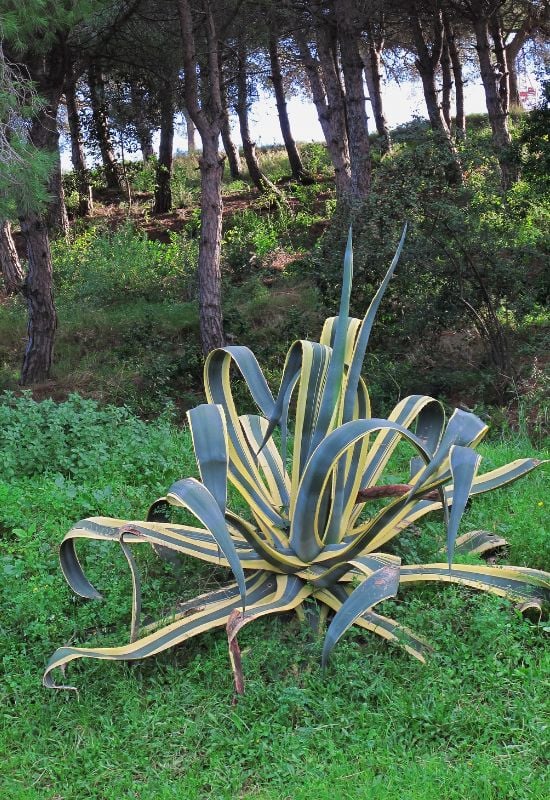
We finally meet a variety with threatening thorn looking spines; ‘Mediopicta Alba’ century plant! It is a very common variety of agave, native to Mexico, and, like many of her sisters, it can give you a very nasty pricking indeed!
The worst are at the tips of its super fleshy and succulent leaves, and they are dark purplish brown, almost black and 1 to 2 inches long (2.5 to 5.0 cm). But, above all, they are incredibly sharp!
They can even penetrate your muscles and they are very, very painful indeed! If you have children or pets, I strongly suggest cutting them off, which is easy to do with a pair of scissors, at least at low levels, because they can literally blind you if you get them in your eyes. Smaller and less dangerous thorns appear on the edges as well.
The foliage is striking, though! Touch it, and it will feel like rubber, look at it and you will see a big rosette blade like, often arching beauties with blue and cream yellow stripes! Winner of the coveted Award of Garden Merit by the Royal Horticultural Society, it has, however, also another threatening trait. And it’s its bloom!
Growing on a 15 feet tall quiote, or stalk (4.5 meters) the flowers are large and greenish yellow, very attractive indeed. But it can break and fall on your head. Actually, it will at some stage, because it is a monocarpic plant, which means that it only flowers once, at the end of its life. However, it will also produce offsets at the base that you can use to propagate it…
An absolute colorful and thorny wonder, ‘Mediopicta Alba’ century plant is quite common to hedge or set the borders of xeric, succulent, desert and Mediterranean gardens, but you could grow it in an urban or gravel yard as well. Maybe as an accent or specimen plant for its sculptural qualities.
5: English Holly (Ilex aquifolia)
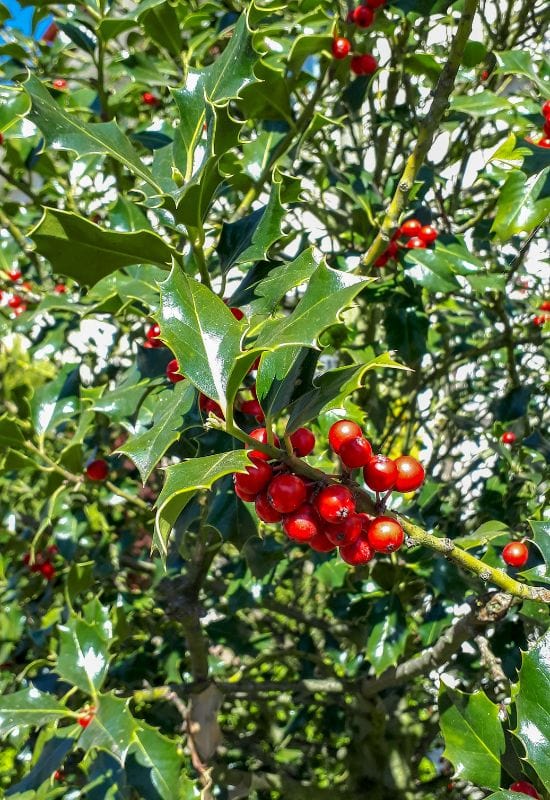
And here is another thorny shrub, but with a very different personality from our agave. And, in fact, its spines grow on leaves which we associate with snowy Christmas, not with sandy and arid deserts!
Native to north Africa, western Asia and Europe, English holly will produce these pointy outgrowths only on the foliage of the lower branches, to defend itself from hungry herbivores, while higher up, the margins will be smooth.
Very glossy, leathery and deep hunter green with bluish reflexes, it also has two shapes in the two levels: ovate above and spiked below, to the point of looking like it is lobed (though it isn’t technically).
They are sharp enough to be uncomfortable, but not really dangerous. But this evergreen beauty also blossoms once a year, with a profusion of small white flowers in the spring!
These then become berries on female specimens, and they ripen slowly till they reach the most vibrant notes of scarlet to carmine red in winter, where they literally seem to shine.
And if you want a twist, pick the variegated ‘Ferox Argentea’ cultivar, which has won the Award of Garden Merit by the Royal Horticultural Society thanks to its cream colored edges (and thorns)!
Great for wildlife in temperate regions, very strong and healthy, this thorny shrub is a real asset for birds, which can nest among its prickly leaves and shelter from predators. Of course, it is also of great value in tall, impenetrable evergreen hedges, windscreens, for foundation planting and as a specimen!
6: Firethorn (Pyracantha spp.)
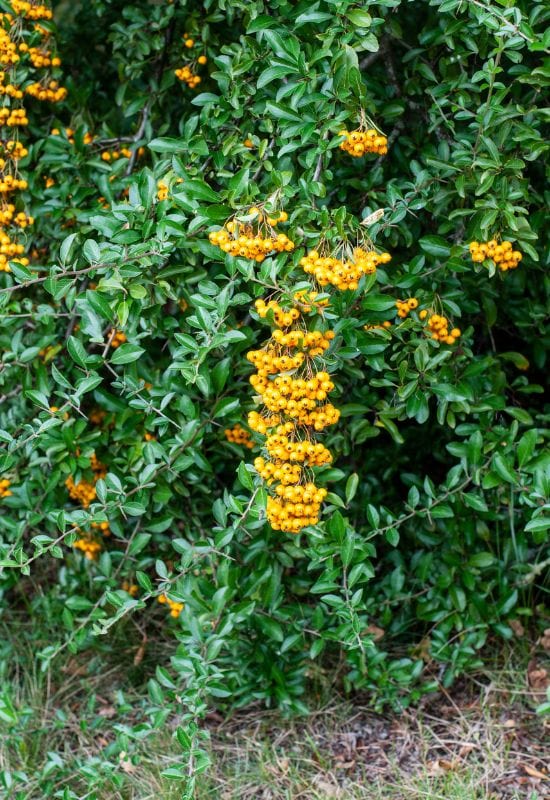
A very popular shrub all over fences of gardens in temperate regions, firethorn can defend your property with its sharp thorns!
In landscaping, three main species are used to create a thick mesh of branches with a “sharp piercing armor”, Pyracantha angustifiloia, P. coccinea and P. koidzumii, and all offer you an impenetrable green wall of lush, ovate or lance shaped and semi glossy dark green leaves, which, being semi evergreen, will last through the winter months in warmer areas.
And this makes it very useful and loved in urban gardens, because if you trim it when young, it is really impossible to see through this barrier, and you get full privacy!
In late spring to early summer, it fills with a profusion of little white flowers, small but very numerous indeed, but then… As soon as the blossom is spent, they turn into a sea of round berries, which attract lots of birds to feed on them!
This is arguably the main spectacle that this plant gives you, and you can choose between varieties in bright orange, scarlet or crimson red, and even with some ruby notes! They are quite glossy and they come in large clusters, and you can also have a dwarf cultivar, ‘Gnome’ which only grows to 4 or 6 feet tall (1.2 to 1.8 meters), but up to 8 feet in spread (2.4 meters).
The perfect thorny shrub to isolate your garden fully from curious eyes, but attract lots of birds to it, firethorn is quite vigorous and adaptable to many landscaping styles, including formal ones, as it is topiary friendly!
7: Prickly Pear (Opuntia spp.)
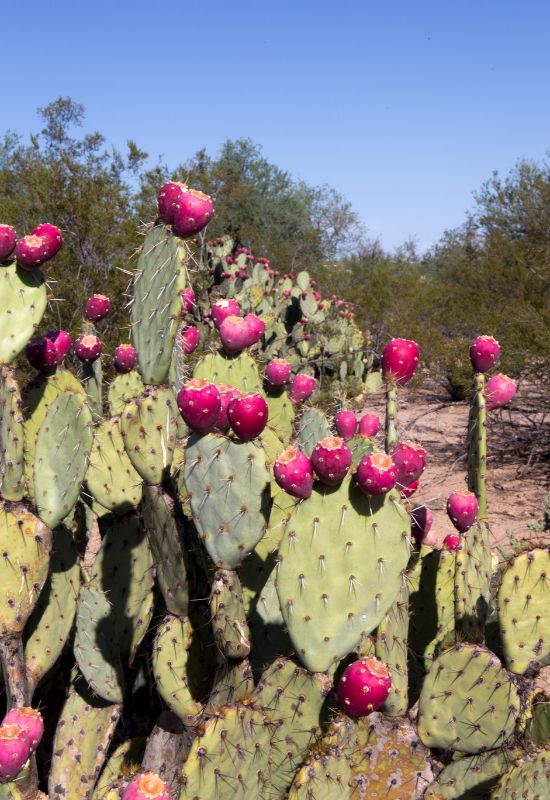
And we come to the most painful thorny beauty of all: prickly pear, or Opuntia! Jn fact, this succulent shrub has two different types of spines… Some are ticker and shorter, and they grow on the pads (its round and fleshy leaves).
But these are not the worst, and some varieties are virtually smooth and innocuous… But this plant is very careful to protect its juicy, delicious fruits… And there you will find the real threat! These are very long, transparent and almost invisible!
But they really, really hurt and they are very difficult to remove! They also fall off freely un the wind! Getting to the sweet figs is a dangerous affair, best done in the morning, and you can have them in yellow, orange and red!
There are also small species and cultivars, as well as large ones, in bright green or blue or even with purple blushes! The flowers, however, are spectacular! They can last from late spring to mid summer, and they look like waxy crowns in bright shades of golden, rose, orange and scarlet!
Despite its amazing spines, or maybe because of them, prickly pears offer corridors for small fauna, protecting them from predators. They are very vigorous and drought tolerant and they will offer your land a natural wall against intruders and – what is more – even against fire! Yes, because these shrubs are so packed with water that they never burn!
8: Japanese Flowering Quince (Chaenomeles speciosa)
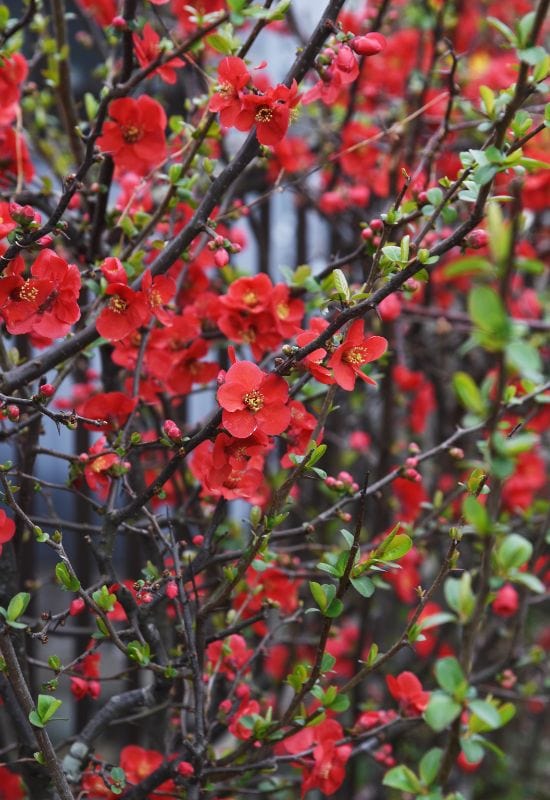
And here is another lovely shrub for temperate and even cold gardens with a sharp edge: Japanese flowering quince! Having said this, it does not seem to mind chilly temperatures, because it blossoms from early or mid spring, when its thorny branches fill with very round and sweet looking blossoms, 1.5 to 2 inches across (3.0 to 5.0 cm), with a very gentle, dreamlike personality!
Ideal for a countryside or traditional looking hedge, you do have a wide choice of varieties with blossoms in white, pink (even salmon!), orange, red and even pale lime green!
There are both single flowered and double flowered cultivars as well, so, you just need to take your pick! The floral display occurs when the plant is still almost fully naked, so you can actually see its sharp thorns.
But they are not many, nor particularly painful, but still strong enough to give you a good barrier from intruders! Then, the foliage develops, with its mid green and ovate leaves, and in the meantime… It will also grow greenish yellow fruits, about 2 inches across (5.0 cm) and edible! They are particularly good for jams, and very much loved by birds as well!
Ideal for a cottage or English country garden, Japanese flowering quince is a thorny beauty you can grow in hedges or naturalized areas, but it is also an ideal foundation plant for a charming floral display in your spring garden.
9: Honey Locust (Gleditsia triacanthos)
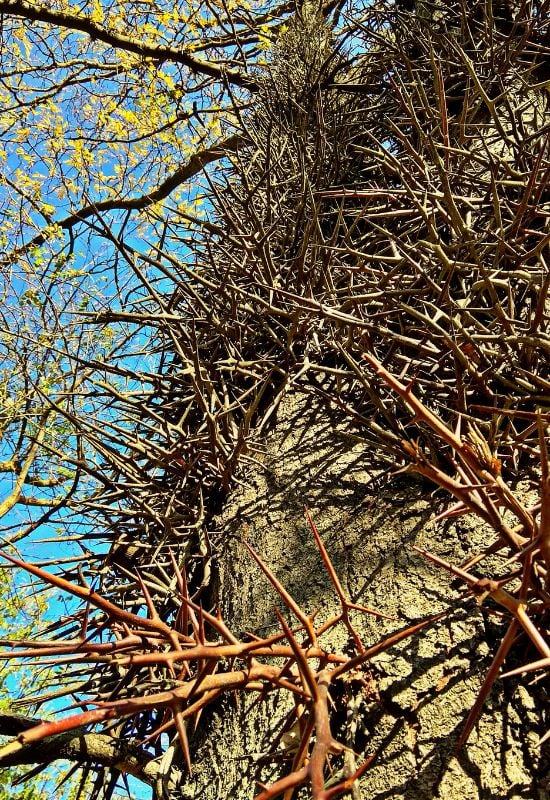
Native to North America, honey locust can give you a really nasty sting if you try to climb it! In fact, its trunk and branches are protected by a dense mesh of thorns that are both sharp and very long, up to 3 inches each (7.5 cm)!
On the other hand, this medium sized tree gives you a decorative round crown with an open habit, so it is a great choice if you wish to underplant it. And it will also offer you amazingly fine foliage, with bright green frond like pinnate leaves that turn to lovely shades of yellow and orange in the fall, before dropping.
Panicles of small and greenish flowers will appear on the branches in late spring and early summer, hanging beautifully and attracting pollinators.
They are nit showy but very rich in nectar, and a great help to the local fauna. And these turn into very long dark brown seed pods, about 18 inches from tip to end (45 cm). And these can be fed to animals as well, being very rich in nutrients.
Very cold hardy and strong, honey locust could work well as a specimen tree or in groups in an informal garden or even naturalized area. It can also spread quite fast, and it has low demands, so, it is also ideal for reforestation projects.
10: Bougainvillea (Bougainvillea spp.)
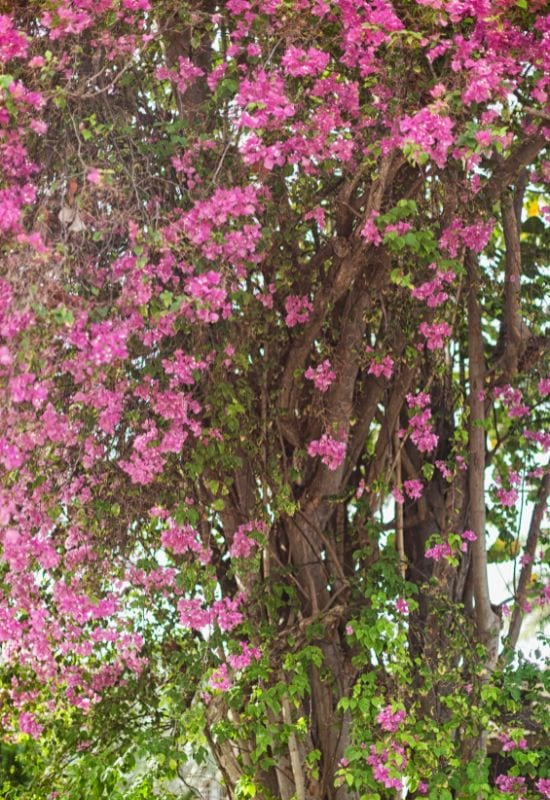
Here is another flowering giant for you if you live in a hog country: bougainvillea! You may not even notice that it actually has long and sharp thorns, that can be up to 2 inches long (5.9 cm)! Why? Because it can literally fill with flowers!
The whole climbing shrub, in fact, can change color and turn yellow, orange, white, pink or red, depending on the variety you pick! And it can do it all year round, in waves!
These are not actually the real flowers, which are small, tubular and cream in color, but the triangular bracts, that look like paper, which accompany the blooms… And this display will also fill with butterflies, bees and even hummingbirds!
The evergreen foliage too is very dense, with dark green broad and lance shaped leaves, semi glossy and creating an impenetrable wall! Fast growing and vigorous indeed, bougainvillea can be an amazing solution for large jobs, covering whole walls and fences within a season, and giving you both privacy and security from intruders.
A real classic of Mediterranean gardens, bougainvillea is a life changing thorny plant when it comes to landscaping; you could also grow it on the walls of your house, and they will never look the same again. Wherever you plant this sunny beauty, it will definitely take center stage! But smaller varieties will also fit in containers and on terraces.
11: Blackberry (Rubus fruticosus)
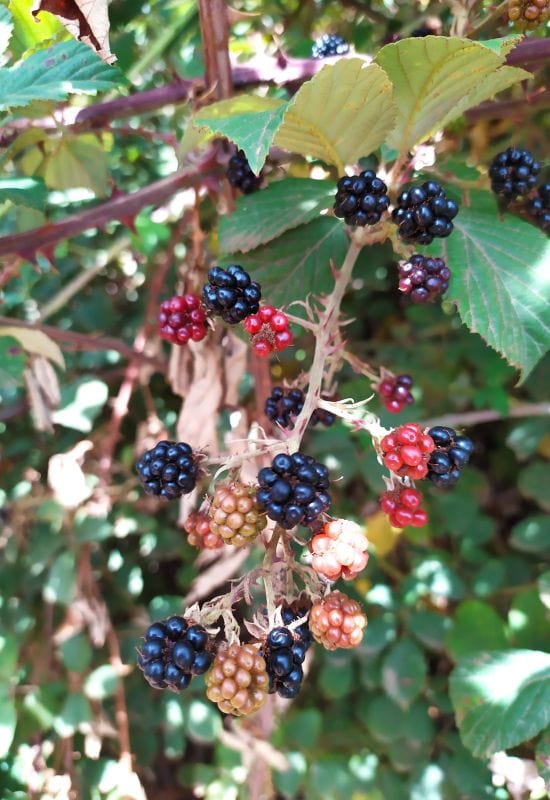
Native to much of Europe, blackberry is one of the most popular and widespread thorny shrubs in all temperate regions of the world. And in fact, you may have seen it grow spontaneous on roadsides, or on the edges of wooded areas.
And you must have seen its famous, sweet and dark purple, almost black fruits on shelves of grocers’… But it is also a flowering plant, and a relative of the rose, a member of the Rosaceae family!
And like its more popular sister (with gardeners, at least) it will produce lovely flowers with five delicate petals in late spring and early summer, loved by pollinators, bees and butterflies.
These blooms also have a lovely tuft of stamens with dark reddish brown anthers, and a lime yellow center to draw you eye in. The actual thorns grow on a dense mesh or flexible and rambling branches (actually canes), and they are actually prickles (like with roses again).
They are not long, but they are hooked, and quite sharp indeed. Following the same theme, the leaves are pinnate, split into five lance shaped, serrated and broad leaflets. But of course, it is the long season of juicy berries that makes it attractive, and there are now many thornless cultivars as well!
Also called briar, or bramble, blackberry is perfect for naturalized areas or kitchen gardens, where this dense thorny shrub can form natural barriers against intruders and at the same time provide corridors and shelter for small fauna. However, be aware that it can spread very fast and become invasive; and it is virtually impossible to eradicate…
12: Spiny Pincushion Cactus (Mammillaria spinosissima)
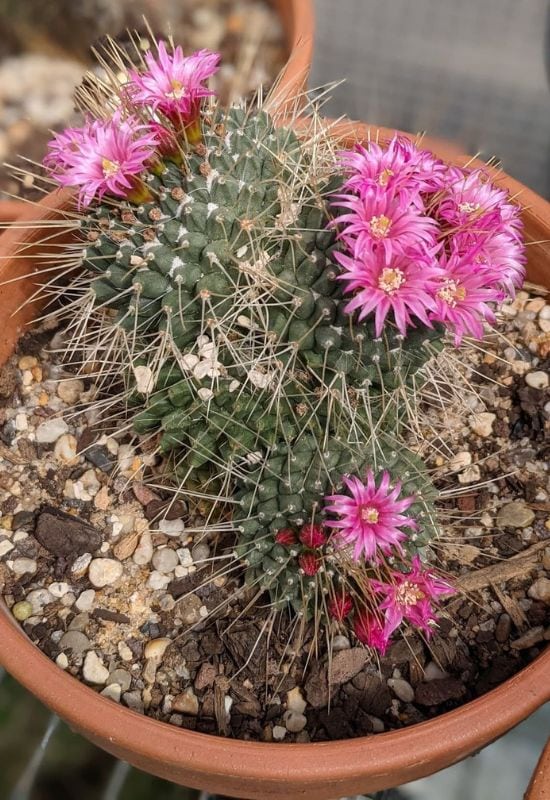
And we come to a small, Sun loving but very “prickly” flowering variety: spiny pincushion cactus… We picked it among all other cacti because its spines (not thorns, to be correct) are some of the most impressive.
In fact, the whole plant is literally covered in them, and they emerge in rays from central points, called “areoles”, forming a very elegant geometric pattern. They are white, but they blush to orange, russet, pink or even purplish especially towards the upper part of this small succulent.
Underneath you can see the waxy surface of the stem, which can be pale green with bluish shades, or sometimes a bit darker, even with tan tonalities. The overall effect is that of a little cylinder hidden under barbed wire, and totally impenetrable.
Spring will see it blossom, with a ring of deep rose flowers, on the bright magenta side, that look like little crowns around the head of this spiky and bristly winner of the Award of Garden Merit by the Royal Horticultural Society…
Slow growing and small, spiny pincushion cactus will look great in containers, but also in a rock, gravel, desert or xeric garden, where you can have it in flower beds. It will also produce lots of offsets that you can use to propagate it, or let it form little but decorative clumps…
13: Japanese Barberry (Berberis thunbergii)
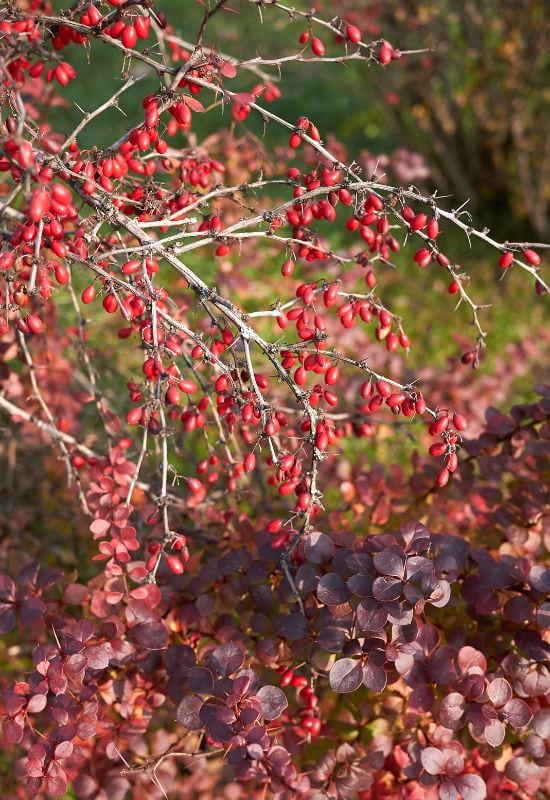
On to another little beauty that can give you a bad “sting”: Japanese barberry. In fact, this shrub has sharp thorns all over its branches, and they are quite difficult to see. This is why they are also covered by lots of tiny, ovate and deciduous leaves, which can be very attractive indeed!
This is also because you can choose the color of the foliage from a very large palette, depending on the variety you pick. For example, ‘Golden Rocket’ has lime green with yellow overtones, ‘Crimson Pigmy’ is a dwarf with purple and red, while ‘Atropurpurea Nana’ has softer shades on the crimson to ruby range.
These last two have also won the Award of Garden Merit by the Royal Horticultural Society, despite their diminutive size. In mid to late spring, they will fill with lots of small but highly scented flowers, in tonalities of greenish to yellowish, with a sudden change of mood and personality.
And these blossoms will turn into very glossy, pendulous berries in bright scarlet, and they will last all the way to the end of the season, before the foliage drops… And then you can finally see the hidden thorns!
Great for edging and flower beds, these varieties of barberry are tough and strong, and larger ones can also work well in hedges, and they are deer resistant too. But you could also choose to grow one as a specimen plant, thanks to its long lasting season of interest.
14: Natal Plum (Carissa macrocarpa)
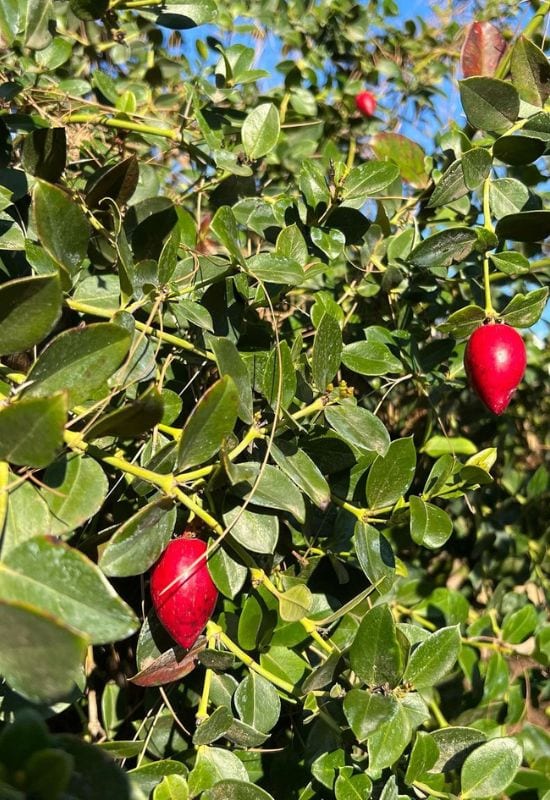
Native to southern Africa, Natal plum is a spiny shrub with many local names, including num-num and amathungulu (in Zulu), and its fruits are called noem-noem… Because, as you may have guessed, they are edible, plump, roundish (with a narrow tip though) and they ripen to glossy ruby to crimson, and if the weather is mild, they can be a source of food all year round.
Excellent for jams, they come after a long lasting bloom that spans spring and summer, and the star shaped flowers have a very heady and heavenly scent, which intensifies at night… Popular belief has it that the whole plant except the fruits is poisonous, because if you cut it it produces latex, but this appears to be a myth and it is not toxic at all.
The thorns hide at the armpits of the branches, and they are quite sharp, so careful when you harvest it… And of course, it will also offer your garden lovely foliage, in winter too, being evergreen. The leaves are small and ovate, very fleshy and shiny, and of a beautiful dark green color. The whole plant has something to offer any time of the year!
An ideal shrub to grow a medium sized hedge of impenetrable thorny branches, dense foliage, great flowers and delicious fruits, Natal plum is is also ideal for coastal gardens, as they perfectly reproduce its native habitat in the south of Africa.
15: Giant Rhubarb (Gunnera manicata)
And we close with a really impressive perennial with with thorns: giant rhubarb! If you have seen it, you will know that it is easy to think that it is actually a tree or shrub, and that it looks like a species that has come to Earth from outer space… Let’s see why…
It has no real thorns, to start with, but spines, and these will occur all over the sturdy, fleshy stems that grow fast and tall… Yes, it can reach more than 10 feet in a single year! The fact is that everything about this native to Brazil is on a massive scale!
Of course, they need to be strong, because the leaves can reach 6 feet across (1.8 meters)! And they are held mainly horizontally like huge parasols, with their deeply cut, maple like shape, and very rough looking texture… This alone gives it an incredible sculptural quality, and the bright to mid green color completes the wow factor…
But wait… The blooms will appear in summer, and they are jaw dropping! They are actually upright panicles that look like cones, and they can be 6 feet from top to bottom (1.8 meters)! The color is of a dark purplish brown shade, though these are bracts, while the actual florets inside are reddish green…
A favorite in exotic gardens, giant rhubarb is simply a spectacular spiny plant, with no equals, and if you have seen it in gardens, you will know that it likes to grow next to water, on pond banks, in boggy places, where it always and invariably steals the show.
This tropical giant will also grow well in coastal gardens, and to be honest I have seen it in a famous English country garden in the postcard cottage village of Cockington (UK), and it looked fabulous!
There’s No Rose with No Thorns, but Many Beautiful Spiny Varieties with Lovely Flowers!
Ok, it’s not true that there’s no rose without thorns…
But for sure this is the most famous thorny (prickly) flowering plant of all… But now you know that there are many others, that you can grow for their beauty, but also to make your hedges and fences a bit more impenetrable to humans (and sometimes hungry deer)…
And there are varieties for hot and cold gardens, formal and informal ones… Your choice is big – but always thorny indeed!

Written By
Amber Noyes
Amber Noyes was born and raised in a suburban California town, San Mateo. She holds a master’s degree in horticulture from the University of California as well as a BS in Biology from the University of San Francisco. With experience working on an organic farm, water conservation research, farmers’ markets, and plant nursery, she understands what makes plants thrive and how we can better understand the connection between microclimate and plant health. When she’s not on the land, Amber loves informing people of new ideas/things related to gardening, especially organic gardening, houseplants, and growing plants in a small space.

